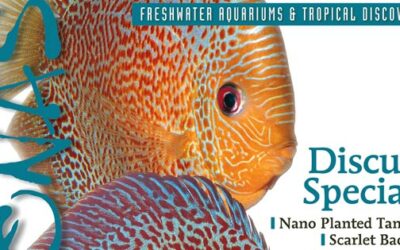The next morning, though, we were greeted with a surprise. We saw gorgeous fishes radiating bright red all over their bodies, with a hint of pink and bold black edgings to the fins.There was no longer any trace of pop-eye! Had it been the long period of transportation or the pure oxygen I had put in the bags at the meeting? We had no idea—the main thing was, they were healthy. We both sat in front of the tank and celebrated like small children, even after several decades together in the aquarium hobby.
AMAZONAS Excerpt Articles
AMAZONAS Preview: January/February 2013
The first issue of AMAZONAS for 2013 will feature angelfishes and will have a publication date of December 4, 2012.
AMAZONAS Nov/Dec 2012 Digital Edition
AMAZONAS completes its first year of publishing in English with an issue covering discus breeding and husbandry with contributions from an international array of experts:
Belo Monte: Protests mount against “Monster Dam” on Brazil’s Rio Xingu
Biologists and human rights observers are calling it an epic disaster in the making, a massive river-damming complex in the heart of the Amazon basin that threatens tens of thousands of native rainforest dwellers and the fish populations that sustain them and enrich the aquarium world.
New Pike Cichlids from Argentina
Several species of pike cichlids from the Río Uruguay drainage in Argentina have begun to be exported in recent years. The most attractive of these, including Crenicichla minuano, C. hadrostigma, C. missioneira, and C. tendybaguassu, started to appear in 2006. Unfortunately, just five years later these lovely fishes had virtually disappeared into oblivion, despite the successful breeding of what was arguably the most interesting species, Crenicichla tendybaguassu (Big Lip Pike Cichlid), by Matthias Kählig in Hannover, Germany.
Licorice Gouramis
All the licorice gouramis of the genus Parosphromenus that are known live in stained blackwaters. Note, however, that blackwaters aren’t really black, but a dark red-brown color, produced in part by peat-like materials but mainly by the decomposing leaves of trees and scrub that grow close to the banks. These dead leaves accumulate in multiple thick layers and release numerous substances, especially humic substances, which prevent any noteworthy population of bacteria in the water. These substances are very important to the health and well-being of the resident fishes, and often even essential for their survival.
Successful Breeding of the Sunshine Pleco
The beautiful Sunshine Pleco is native to the middle and lower Río Xingu. Juveniles and half-grown specimens live in water depths of 3.28–9.8 feet (1–3 m), while adults inhabit the very dark environment of deeper water. To replicate their natural environment, we keep our loricariid catfishes in a darkened room; the only light comes from one open door. Only during daily maintenance and feeding do we turn on a dim light. We are sure that this is a major element in our success, and not just with this particular catfish species. Obviously, it would be impractical for the average aquarist to keep fishes in pitch-dark rooms, but it is worth trying with species that have so far resisted attempts to get them to breed.
Upcoming Article for Amazonas Magazine
Recommended reading list for the article, The Endangered Cichlid Fishes of Lake Victoria, East Africa, by Paul V. Loiselle and Jay Hemdal. AMAZONAS Magazine May/June 2012.












